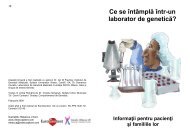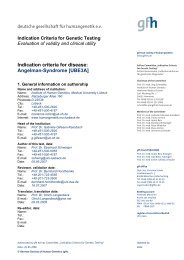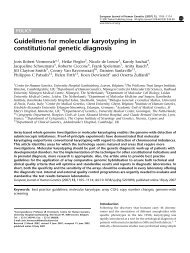Cytogenetic Guidelines and Quality Assurance - EuroGentest
Cytogenetic Guidelines and Quality Assurance - EuroGentest
Cytogenetic Guidelines and Quality Assurance - EuroGentest
Create successful ePaper yourself
Turn your PDF publications into a flip-book with our unique Google optimized e-Paper software.
used) controls. It is recommended that centrally<br />
monitored alarm systems are available.<br />
18<br />
Laboratories performing prenatal analyses should<br />
possess at least two incubators for splitting of prenatal<br />
specimens. It is also recommended that prenatal <strong>and</strong><br />
non-prenatal cultures are incubated separately to<br />
minimise the risk of microbial cross-contamination.<br />
4.2.3 IMAGE CAPTURE SYSTEMS<br />
To maintain a high quality service provision all image<br />
analysis systems should be maintained regularly with<br />
software upgrades.<br />
The number of image processing systems should not<br />
be a limiting factor in specimen analysis. When using<br />
image analysis systems, one part of the analysis process,<br />
either the initial analysis or the checking, should<br />
be completed using a microscope to ensure small<br />
markers or additional chromosomes have not been<br />
overlooked.<br />
To avoid unnecessary delays due to image systems<br />
faults/failure, a service agreement is highly recommended.<br />
4.3 TECHNICAL ASPECTS<br />
OF CYTOGENETICS<br />
4.3.1 CELL CULTURES<br />
Duplicated or independently established cultures,<br />
where possible, are recommended for all types of cultured<br />
specimens.<br />
4.3.2 BANDING<br />
All karyotyping should be carried out using a b<strong>and</strong>ing<br />
technique. In no cases, except some chromosome<br />
breakage syndromes, should a report be issued without<br />
cells having been subjected to full analysis of the<br />
b<strong>and</strong>ing pattern for the whole chromosome complement.<br />
The ISCN defines five levels of b<strong>and</strong>ing. This can be<br />
used as a guide for establishing the degree of resolution<br />
required in producing a result. Several useful<br />
methods have been developed to help assess b<strong>and</strong>ing<br />
quality. Some countries e.g. Germany <strong>and</strong> the UK use<br />
an alternative approach that designates a quality score<br />
representing which chromosome b<strong>and</strong>s are visible at<br />
250 (QAS 2), 350 (QAS 4) <strong>and</strong> 550 (QAS 6) bphs<br />
resolution. More information can be found on the<br />
ACC (www.cytogenetics.org.uk under info) <strong>and</strong><br />
BVDH (www.gfhev.de/en/membership/ under quality<br />
management) websites.<br />
Numerical <strong>and</strong> structural abnormalities have to be excluded<br />
at a b<strong>and</strong>ing level appropriate to the referral<br />
reason. One or more objective <strong>and</strong> reproducible method(s)<br />
must be used to assess b<strong>and</strong>ing resolution <strong>and</strong><br />
must be described in the laboratory protocol book or<br />
User Guide.<br />
A st<strong>and</strong>ardised method for assessing b<strong>and</strong>ing quality<br />
should be used, with an agreed minimum st<strong>and</strong>ard that<br />
may vary depending on the reason for referral. Full<br />
analysis must be completed to the satisfaction of the<br />
supervisor that numerical <strong>and</strong> structural abnormalities<br />
have been excluded to a level appropriate for the referral<br />
reason. Specific st<strong>and</strong>ards for resolution should<br />
be appropriate to the case <strong>and</strong> the type of tissue<br />
studied. The 400 bphs (QAS 4) level is the minimum















